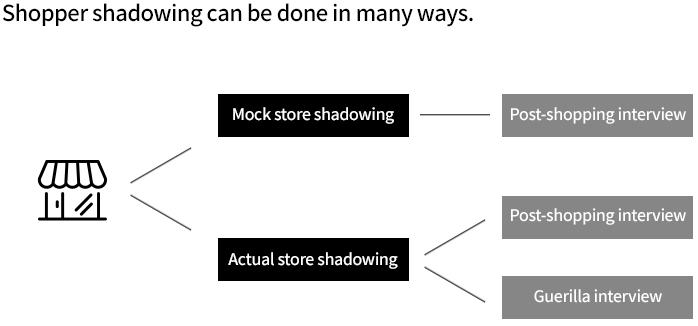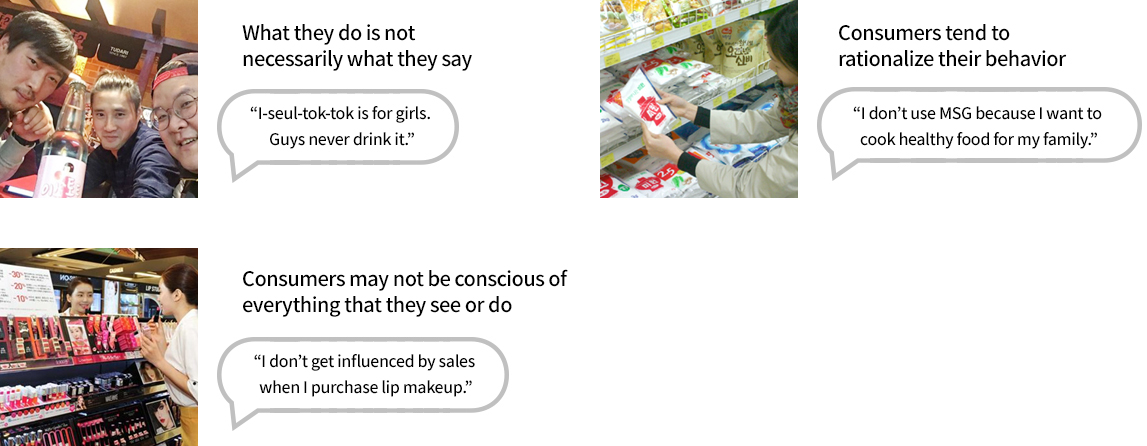WHAT WE DO

TRADITIONAL
- Traditional and the most commonly used methods
- Typically invite target samples to a research facility
- Information is collected through conversations
and interactive discussions
 |
|
 |
|
 |
|

 |
|

ETHNOGRAPHIC
- Ethnographic approach
- In-situ observation where researchers go into consumers’ real-life environment or to the market
- On the basis of understanding sociocultural background
 |
|
In-home interview
- An interview is conducted in consumers’ homes where they can comfortably talk about their thoughts and feelings while sharing a piece of their daily life.
- Being in the consumers’ living environment and listening to their unfiltered opinions enables us to observe the reason of disparity between what they say and what they actually do.
- Demonstration of certain behaviors or habits which happen in the house either through completion of diary with photos or self-recorded videos to gain deep insights and understand their actual usage and consumption attitude.
- By conducting pantry check or bathroom check, we are able to gain insights and their real perceptions towards different brands and products.
- Effective to understand lifestyle or product usage behavior through observation in the cases when home visit is not feasible due to time or cost limitations.
- For observation of particular usage of product or certain behavior over a relatively longer period of time (e.g. several days, one week, etc.)
- A surveillance camera is installed in consumers’ homes to record consumers’ most natural environment and to uncover unconscious behaviors and needs.
- The recordings (“raw data”) are then analyzed by bo:m researchers to identify meaningful data.
- As it requires consumers’ agreement (to install surveillance camera in their homes) and long analysis process, the down side of this methodology is high cost implications.
Show and tell
Passive camera

 |
|

 |
|
Street safari, store safari, etc.
- Safari ca be conducted at specific areas or locations (e.g. streets, stores, etc.) to understand market and
social phenomenon by examining consumer behavior,
attitude, and other non-verbal cues. - Researchers are engaged in “pure observation” for a significant amount of time to
record and accumulate observation to extract market tendency or a noteworthy phenomena. - Safari can be used effectively either to create or confirm hypotheses.
- At Research House bo:m, we believe in the power of observation. We invest significant amount of time training our researchers
to observe not to simply “see” but to catch meaningful data from what they observe and
also to read the meaning behind consumers’ unconscious behaviors. - Through observation, we are able to obtain rich information from consumers’ unconscious behaviors,
unmet needs which they are not even aware of, and their actual behavior behind their rational thinking process. - Observation can help overcome the following limitations:
“Power of observation”

 |
- What are they ignoring? - What are they focusing on? - What is they first thing they look at? - What is the natural flow of their eye movement? - What do they look at for the longest time? - Etc. |

DIGITAL
- Less structured than other methods
- Use of digital medium or device to
collect information and market data - Analysis of digital communication as a market data
 |
|
 |
|
 |
|

INNOVATIVE
- Innovation workshop involving creative ideation
techniques togenerate new ideas for development of
product, concept, or marketing strategies
 |
|